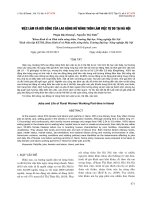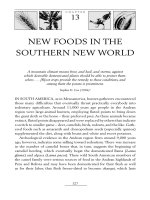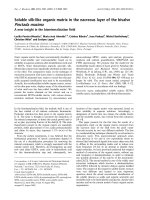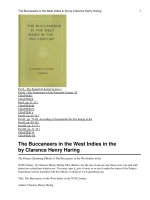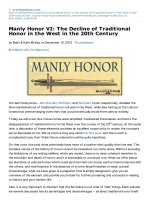New buddhism in the West
Bạn đang xem bản rút gọn của tài liệu. Xem và tải ngay bản đầy đủ của tài liệu tại đây (86.62 KB, 4 trang )
New Buddhism in the West
Buddhism in the West might be seen as the latest stage in Buddhism's cultural immigration.
However, it makes a substantial contribution to this history and is sometimes referred to as a
"new Buddhist vehicle" or the "New Buddhism" as a whole. Buddhism in the West includes a
variety of groups, customs, and philosophical viewpoints. This piece provides a general overview
of how Buddhism was incorporated into Western culture and religion.
Firstly, Buddhist practices such as philanthropic activities, education, and providing for the
sick and dying have long emphasized compassion for all sentient beings. However, "socially
engaged Buddhism" refers to the practice of applying the dharma to social challenges in a more
thorough manner than charitable giving or philanthropy, one that hopes to focus on an
individual's pursuit of transcendence toward the collective transformation of society.
The Mahayana concept of nondualism, which holds that at the most fundamental level of
existence, male and female, rich and poor, employer and employed, ruler and ruled are merely
relative distinctions that fall away before the universal Buddha mind or Buddha nature, is one
principle at the heart of much socially engaged Buddhism. In addition, the Buddhist Peace
Fellowship and a set of organizations connected to zen master Thich Nhat Hanh are the two
prominent organizations that have contributed to the most remarkable development of socially
engaged Buddhism in America. Additionally, both groups emphasize the importance of
inspiration over doctrine and are nonsectarian and ecumenical. Both include a visionary feature,
but Thich Nhat Hanh's method has a more openly mystical component that mainly stems from
his Asian heritage and a strong poetic inclination. In addition, the Thich Nhat Hanh movement
has a broader cosmopolitan reach than the Buddhist Peace Fellowship, contributing to its more
multicultural participation.
The teachings of the Buddha, the bodhisattva ideal, and the comprehensive Mahayana
worldview are the foundation of Thich Nhat Hanh's theories. His explanation of the First Noble
Truth that life is characterized by dukkha, or suffering, reveals his philosophy. He emphasizes
that "suffering is not enough" and that social peace begins with individuals' cultivation of
personal peace, which is typical of his positive approach. The cultivation of love, harmony, and
mindfulness can be achieved through meditation, chanting the gathas, and other straightforward
ritualistic activities. These activities should not be used as a means of withdrawal from the
outside world, but rather as a means of preparing for a full and thorough engagement with it.
Gender equity among Buddhists, on the other hand, is a primary concern for New
Buddhism in the West. Since the beginning, women have contributed significantly and in various
ways to spreading Buddhism in the West, especially in the United States. In contrast to women in
Asia, American women emerged as a dominant force as practitioners, teachers, philosophers, and
leaders. A series of scandals from men disrupted religious groups most closely associated with
the counterculture, beginning around, where concern about equity became especially evident.
Those scandals' exact nature and scope are still unknown. While some claim that inappropriate
sexual behavior, excessive drinking, drug use, and power abuse occurred frequently, others
consider these instances isolated. However, specific incidents are unanimously acknowledged to
have involved severe negligence. For instance, a bisexual American teacher who was conscious
of having the AIDS virus engaged in unprotected intercourse for three years in a Tibetan
Buddhist community. Several significant consequences from these scandals affected how to
convert Buddhism developed. They were leadership issues that surfaced during the freewheeling.
1
These incidents demolished the idealistic views that a generation of western students had
about Asian faiths. Many people started to question what Kathy Butler, a devoted San Francisco
Zen Center student, called "an unhealthy marriage of Asian hierarchy with American license that
distorts the student-teacher relationship." They observed how dharma centers frequently behaved
dysfunctionally, with concerns about power and control being covered up in the name of group
spiritual discipline, a situation Butler called "a lineage of denial."
Furthermore, there is ambiguity regarding the attitudes of many Buddhist traditions in
western contexts toward homosexuality, which has a negative impact on whether Buddhism is
liberal.
One of the first people to establish a monastery in America was Master Hsuan Hua, who
saw that homosexuality planted the seeds of rebirth in lower realms of existence. According to
the Korean tradition, Master Soen Sa Nim claimed that homosexuality is a consequence of karma
and that a homosexual can become heterosexual by reciting the appropriate mantras.
One of the most well-known traditions in the US, Soka Gakkai International (USA), once
recommended its gay male adherents marry women and work toward becoming heterosexual.
However, it has changed its attitude and behavior and is now willing to perform same-sex
marriages. According to S. N. Goenka, an Insight Meditation teacher in the US, what he sees as
male and female homosexuality is dangerous. The Insight Meditation viewpoint appears to be
gendered, and their expressions disregard the diversity of culture and society regarding sex and
gender. On the contrary, the Soto Zen community at Shasta Abbey in California accepts both lay
and monastic lesbian or gay members. It does not distinguish between the soteriological potential
of homosexuals and heterosexuals. Soto Zen priest and clinical psychologist, Rev. Daizui
MacPhillamy, has observed that: "Homosexuality does not impede enlightenment, and gay
people are welcome in Buddhist training. How could it be otherwise? How could love
between any sentient beings be contrary to the Buddha Nature? The Buddhist mind understands
that All is One and All is different."
An institutional organization that promotes gender segregation supports androgyny and
views the transcendence of gender as a step on the spiritual path. Lesbians and gays are welcome
at Triratna/FWBO, and outreach initiatives have included retreats and beginning workshops
designed just for them. Triratna/FWBO, like many Buddhist schools, holds that sexuality is
ultimately something to be transcended and that satisfied celibacy is the main objective.
From a perspective view, there are many approaches to Buddhism in the West, whether
they are Zen, Vipassana, or Vajrayana traditions; all schools have the same goal of leading
human beings to happiness. Among the schools, engaged Buddhism of Zen Master Thich Nhat
Hanh has a great movement to adapt to the West's culture. His teachings are easy to understand,
and the practice methods suit Westerners. We can be aware of our breath and live in the present
moment. When we are mindful or fully present in the here and now, anxiety disappears and a
sense of timelessness takes hold, allowing our highest qualities, such as kindness and
compassion, to emerge. Professor of Buddhist Studies at Harvard University's Divinity School,
Janet Gyatso, Hershey said: "Thich Nhat Hanh provides a simple version of Buddhism, but I
would not say it is oversimplified".
Regarding gender issues, we can conclude that Buddhist teachings cannot be fully
comprehended in isolation from cultural contexts based on the range of Buddhist attitudes
toward male homosexuality. Nonetheless, the ultimate goal of Buddhist practice is nirvana,
which can be attained by eliminating attachment and desire. As such, all Buddhists are expected
2
to reduce their sexual desire. If homosexuality is accepted in society, it might also be accepted in
the Buddhism practiced during the Buddha's time. Any modification to standard assessments
would need to respect established practices in Buddhist cultures where homosexuality is not
accepted.
Moreover, the Buddha said that no one, not even the Buddha, would ever achieve
enlightenment if two energies were as powerful as a desire for sex. Only because the impulse to
reproduce has less influence over us than aversion, hatred, and delusion. We must have the
ability to cope with the potent energy of sexuality and do it with skill, attention, understanding,
and wisdom. Even the urge to reproduce is part of our survival instinct and may not be
conscious. It is present in the majority of us on a molecular level. We set specific non-negotiable
criteria when our love turns sexual, and hence relational. If certain conditions are not met, like
fidelity and actions of love and compassion, the relationship will undoubtedly end in a broken
heart, a fragmented spirit, and exhausted mental energy. Relationship conditions do not have to
affect unconditional love. However, the majority of the time, when the container of a loving
sexual relationship is damaged, the love itself is also changed in some way.
Total : 1381 words.
3
References
Article: Origin and Evolution of Buddhism in American Continent.
Books:
Coleman James William. 2002. The New Buddhism : The Western Transformation of an
Ancient Tradition. New York: Oxford University Press.
Dharmachari Subhuti, 1994, Sangharakshita, pp.172, cited by Harvey, 2000,
Ethics, p.428—429.
Roshi D MacPhillamy, 1982, 'Can Gay People Train in Buddhism?', p.28, cited by
Peter Harvey, 2000, Ethics, p.430—431. Punctuation as per Harvey.
Sangharakshita, 1990, A Guide to the Buddhist Path (Glasgow, Windhorse), p.142.
Dharmachari Subhuti, 1994, Sangharakshita, pp.171, cited by Harvey, 2000,
Ethics, p.429.
Dharmachari Subhuti, 1994, Sangharakshita, pp.172, cited by Harvey, 2000,
Ethics, p.428—429.
Peter Harvey, 2000, Ethics, p.429.
Eckel Malcolm David John L Esposito Isaiah Gafni Luke Timothy Johnson Mark W Muesse
and Teaching Company dirs. 2003. The Great Courses. Great World Religions. Teaching.
Harvey Peter. 2013. An Introduction to Buddhism : Teachings History and
Practices Second ed. New York: Cambridge University Press.
Jose Ignacio Cabezon, 1993, 'Homosexuality and Buddhism', p.94
Roger Corless, 1998, 'Coming Out in the Sangha
Seager Richard Hughes. 2012. Buddhism in America Rev. and expanded ed. New York:
Columbia University Press.
Tweed Thomas A. 2000. The American Encounter with Buddhism 1844-1912 : Victorian
Culture & the Limits of Dissent. Chapel Hill NC: University of North Carolina Press.
/>direct=true&scope=site&db=nlebk&db=nlabk&AN=137937.
4


